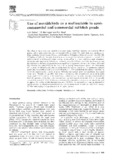Use of metaldehyde as a molluscicide in semi-commercial and commercial milkfish ponds

View/
Request this document
Date
1998Page views
273Metadata
Show full item recordCited times in Scopus
Share
Abstract
The effect of metaldehyde on brackish water pond snails, Cerithidea cingulata, was tested in 250 m2 ponds, and in semi-commercial and commercial milkfish ponds. The field trials were conducted at three locations, namely Luzon, Visayas, and Mindanao, Philippines. Three application rates (80, 100, 120 kg(ha) of 10% metaldehyde formulation, an untreated control and a reference standard 25% niclosamide EC (1.0 L/ha) were tested during the dry season in a pond with heavy snail infestation. Seven days after application (DAA), snail mortality rates (86-87%) did not differ significantly among the various metaldehyde treatments but were significantly higher than those in the control (6%) and the reference standard (29%). In the field trials, in heavily infested ponds (more than 2000 snails/m2), a dose of 120 kg/ha was effective under both dry and wet conditions. In moderately infested ponds (less than 2000 snails/m2), a dose of 80 kg/ha of a 10% metaldehyde formulation was effective under dry conditions but a dose of up to 120 kg/ha was needed under wet conditions. In a pond dosed with 120 kg/ha of the 10% metaldehyde formulation, the concentration increased in pond water, until 3 DAA relative to the initial level, indicating that the active ingredient had dissolved from the granules. From day 3, the concentration declined steadily to approx. 16% of the initially detected amount at 15 DAA. In the pond sediment, the metaldehyde concentration steadily declined to approx. 1% of the initially detected amount at 15 DAA. As metaldehyde is rapidly degraded in aquatic systems its efficacy in controlling brackish water pond snails depends on a high initial dosage.
Suggested Citation
Coloso, R. M., Borlongan, I. G., & Blum, R. A. (1998). Use of metaldehyde as a molluscicide in semi-commercial and commercial milkfish ponds. Crop Protection , 17(8), 669-674. https://doi.org/10.1016/S0261-2194(98)00071-4
Subject
molluscicides  ; testing
; testing  ; sediment
; sediment  ; brackish water
; brackish water  ; fish culture
; fish culture  ; toxicity
; toxicity  ; metaldehyde
; metaldehyde  ; niclosamide
; niclosamide  ; snails
; snails  ; Chanos
; Chanos  ; Cerithidea cingulata
; Cerithidea cingulata  ; Milkfish ponds
; Milkfish ponds
 ; testing
; testing  ; sediment
; sediment  ; brackish water
; brackish water  ; fish culture
; fish culture  ; toxicity
; toxicity  ; metaldehyde
; metaldehyde  ; niclosamide
; niclosamide  ; snails
; snails  ; Chanos
; Chanos  ; Cerithidea cingulata
; Cerithidea cingulata  ; Milkfish ponds
; Milkfish ponds
Collections
- AQD Journal Articles [1231]
